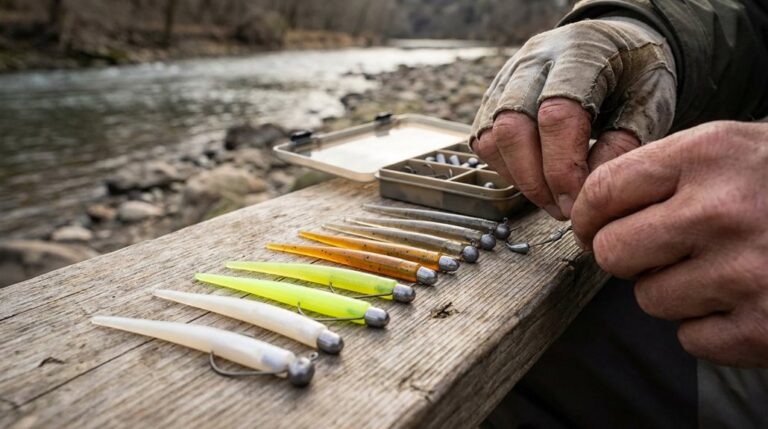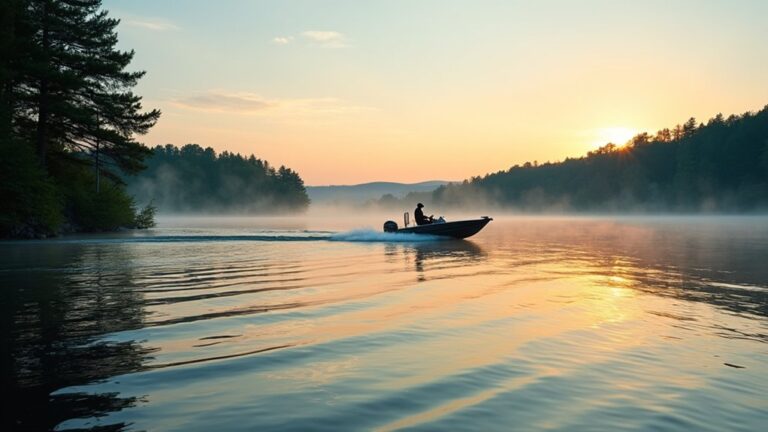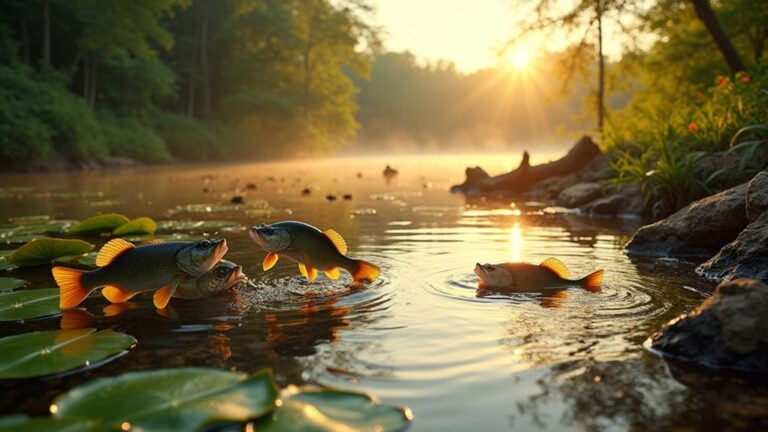Weather notably impacts fishing by influencing fish behavior based on temperature, barometric pressure, and wind. For instance, fish are more active in ideal water temperatures, while rising pressure makes them dive deeper. Wind can either attract baitfish or scatter them, affecting your catch. Pre-storm conditions often spark feeding frenzies, while post-storm fishing can be rewarding within 72 hours. To improve your success, adjust your tactics according to environmental changes and observe prime fishing times. Understanding these factors can enhance your fishing trips, and there's much more to explore about refining your experiences.
Key Takeaways
- Water temperature significantly affects fish activity, with optimal ranges promoting feeding and colder waters enhancing dissolved oxygen levels.
- Falling barometric pressure leads to increased fish activity and aggressive feeding, while rising pressure causes fish to dive deeper and become less active.
- Wind conditions influence fish behavior; onshore winds attract baitfish, while strong winds create waves that boost fish activity.
- Pre-storm conditions often result in heightened fish activity, while post-storm fishing is best within 72 hours as fish resume normal feeding.
- Early mornings and late afternoons are peak fishing times; environmental changes require adjustments in fishing tactics for optimal results.
Weather Factors Affecting Fish Behavior
Weather plays an essential role in shaping fish behavior, and understanding these factors can enhance your fishing success. One key element is water temperature, which greatly affects fish metabolism. For ideal feeding, aim for temperatures between 65°F and 75°F, as fish are more active and likely to bite during these conditions.
Barometric pressure is another important factor. Rapid drops, especially greater than 0.18 inches Hg in three hours, can trigger feeding frenzies, making it an excellent time to cast your line.
Don't forget about the impact of wind; it creates waves that distribute nutrients, attracting fish to specific areas and altering their feeding behavior based on wind strength and direction.
Rainfall can oxygenate the water, encouraging fish to move into shallower, flooded habitats. Light drizzle often leads to heightened feeding activity, so consider fishing after a light rain.
Finally, keep in mind seasonal changes in sunlight, which affect long-term water temperature trends. Fish tend to prefer shaded areas during hot, sunny days, so adjust your strategy accordingly.
Influence of Water Temperature
Understanding how weather affects fish behavior naturally leads to the importance of water temperature. The temperature of the water directly impacts fish activity, affecting their feeding and breathing patterns.
Colder waters generally hold more dissolved oxygen, which boosts fish behavior, making them more active. Here are three key points to evaluate:
- Optimal Temperature Range: Most fish species thrive between 65°F and 75°F, while cold-water species do best below 60°F.
- Impact of Temperature Fluctuations: Rapid changes in water temperature, like those from rainfall, can cause fish to become more active in warmer waters or sluggish in cooler conditions.
- Dissolved Oxygen Levels: Warmer waters tend to have less dissolved oxygen, leading to decreased fishing activity.
Impact of Wind on Fishing
When you're out on the water, wind plays a crucial role in determining your fishing success. Strong winds can create waves that stimulate feeding in gamefish, pushing them into shallower waters. The wind direction also influences fish distribution, with onshore winds bringing baitfish closer to shore, while offshore winds scatter them further out.
Understanding how wind impacts bait movement and fish behavior can greatly enhance your fishing strategy. Here's a quick overview:
| Wind Type | Effects on Water Temperature and Clarity | Fish Behavior & Bait Movement |
|---|---|---|
| Onshore Winds | Warms surface water, increases clarity | Baitfish move closer, attracting predators |
| Offshore Winds | Cools surface water, may decrease clarity | Fish scatter, becoming less active |
| Strong Winds | Creates waves, stirs up the water | Fish become more active, feeding increases |
| Calm Conditions | Water stabilizes, fish retreat deeper | Reduced activity, less feeding |
In windy conditions, adapt your approach. You'll likely find better results as the wind can encourage fish to chase bait and become more active.
Understanding Barometric Pressure
Fishing success doesn't just hinge on wind conditions; barometric pressure also plays a significant role in determining fish behavior. Understanding how barometric pressure affects feeding activity can help you time your fishing trips for greater success. Here's what you should keep in mind:
- Rising Pressure: When barometric pressure rises, fish often dive deeper and become less active. This means they're less likely to bite, so it may be wise to wait for a change.
- Falling Pressure: A sudden drop in barometric pressure can trigger feeding frenzies. Fish tend to become more aggressive and active, especially in shallow waters, making it a prime time for you to cast your line.
- Stable Weather: After around 72 hours of stable barometric pressure, fish typically resume their normal feeding patterns. You can expect them to be more engaged and ready to bite.
Fishing Before and After Storms
Storms can greatly influence fishing conditions, often leading to increased activity right before they hit. As barometric pressure drops, fish sense the impending weather change and become more active, creating a feeding frenzy. This is the ideal time for you to cast your line, as fish move into shallow water to take advantage of the sudden influx of nutrients that storms can bring.
You'll likely find that aggressive feeding behavior is common just before a storm. Fish are drawn to shallower areas where food is abundant, making your chances of a big catch much higher.
However, once the storm passes, you'll notice a shift. The rising barometric pressure often leads to decreased fish activity, causing them to retreat to deeper waters or become lethargic.
Despite the lull immediately following a storm, don't lose hope. The best fishing conditions often occur within 72 hours after the storm as fish return to their normal feeding patterns.
Adjusting Fishing Tactics
Adapting your fishing tactics based on weather conditions can markedly improve your success on the water.
By adjusting tactics according to specific changes in the environment, you'll better align with fish behavior. Here are three strategies to take into account:
- Falling Barometric Pressure: When you notice the barometric pressure dropping, head to shallow waters. Fish become more active and aggressive in anticipation of storms, making them easier to catch.
- Water Colour and Rainfall: After heavy rainfall, water colour often changes, becoming murky. Bright lures can help increase visibility, pulling fish from their hiding spots in flooded habitats.
- Cooler Temperatures and Overcast Conditions: In cooler temperatures or overcast conditions, adjust your bait size. Larger baits can be more effective as predator fish are more aggressive and willing to venture into shallower waters during these times.
Importance of Timing
Understanding the timing of your fishing trips can make all the difference in your success on the water. Ideal fishing times often correlate with favorable weather patterns, particularly during periods of falling barometric pressure. These conditions can lead to increased fish activity and even feeding frenzies.
Stable weather conditions yield more consistent results, as fish tend to be more active and feeding. Recognizing peak activity times—like early mornings and late afternoons—can enhance your chances of a successful catch. During these periods, fish are more likely to be on the hunt for food.
Here's a quick reference table to help you plan your fishing trips:
| Weather Condition | Ideal Fishing Time | Notes |
|---|---|---|
| Falling Barometric Pressure | Early morning & late afternoon | Increased fish activity |
| Stable Weather Conditions | All day | Consistent feeding opportunities |
| Rising Barometric Pressure | Midday | Fish may be less active |
| Post-Storm Conditions | Early morning | Fish often feed aggressively |
Fish Mobility and Aggression
Fish mobility and aggression are heavily influenced by weather conditions, affecting your chances of landing a big catch. When the temperatures are warm and stable, fish tend to be more aggressive, leading to increased bites and active feeding behavior.
However, when cold fronts move in, fish mobility decreases, causing them to retreat to deeper or shaded areas where they become sluggish.
Here are three key points to take into account about fish behavior in relation to weather:
- Warm Weather: Fish are more mobile and aggressive, increasing your chances for a successful catch.
- Cold Fronts: These lead to decreased mobility and feeding, as fish seek refuge in cooler, deeper waters.
- Overcast Conditions: Fish feel more secure in lower light, often venturing into shallower areas, which can enhance their aggression.
Understanding how weather patterns impact fish mobility and aggression is essential for maximizing your fishing success.
Ideal conditions can provide the right amount of oxygen available for fish, prompting them to resume feeding. Keep an eye on those temperatures and plan your trips accordingly!
Responsible Fishing Practices
In the pursuit of a successful fishing trip, adopting responsible fishing practices is vital for ensuring the health of fish populations and the surrounding ecosystem. By following local regulations, you not only comply with the law but also contribute to sustainable fish populations. Always check the weather before heading out, as conditions can change rapidly, impacting both safety and fishing success.
Utilize catch-and-release techniques, especially for non-target species or in areas with declining populations, to promote ecological balance. Proper handling of fish is important; wet your hands or use appropriate tools to minimize stress and injury. This helps increase survival rates post-release.
Here's a quick guide to responsible fishing practices:
| Practice | Description |
|---|---|
| Follow Local Regulations | Stay informed about size limits and seasons. |
| Catch-and-Release Techniques | Release non-target species to sustain populations. |
| Clean Up After Fishing | Dispose of trash and gear to protect wildlife. |
Conclusion
In summary, understanding how weather impacts fishing can greatly boost your success on the water. Did you know that fish are often 30% more active during overcast conditions? By adjusting your tactics based on weather factors like temperature, wind, and barometric pressure, you can improve your chances of landing a big catch. Remember to fish responsibly—protecting the environment guarantees that future generations can enjoy the same thrilling experiences you do today. Happy fishing!




